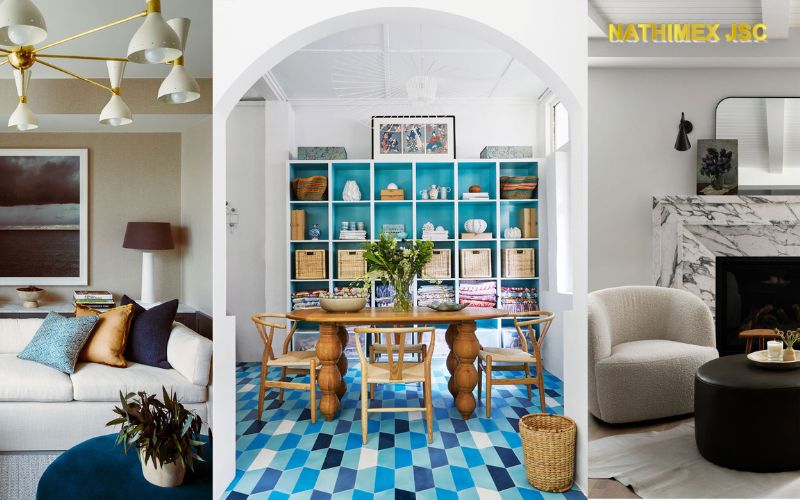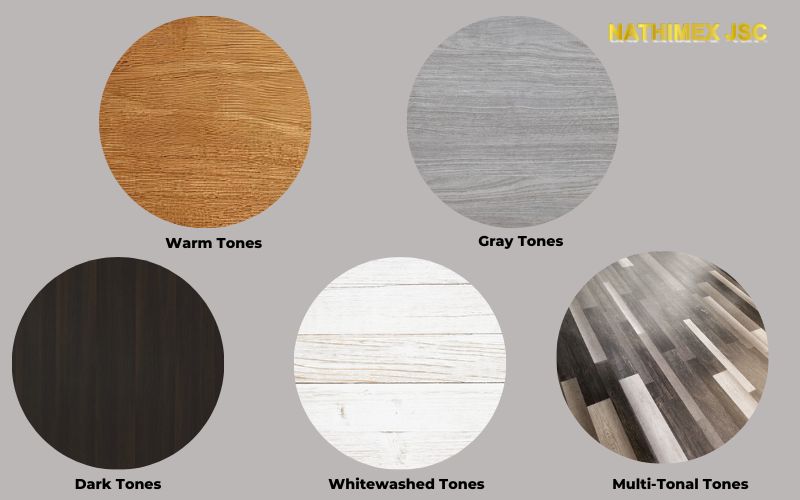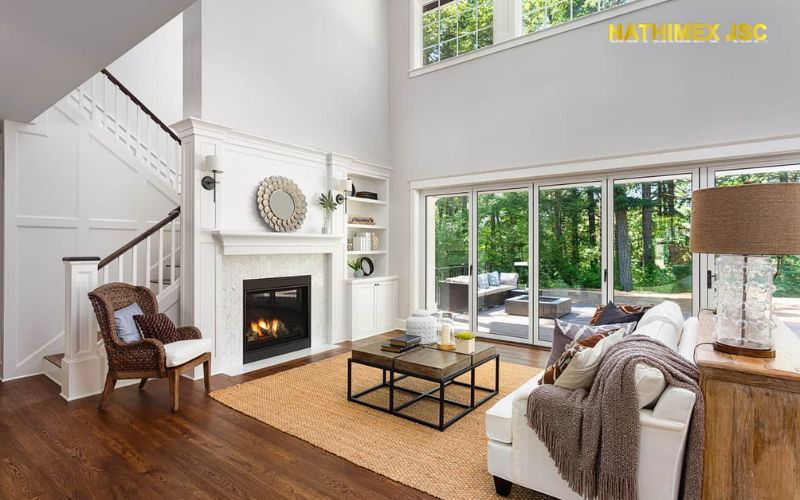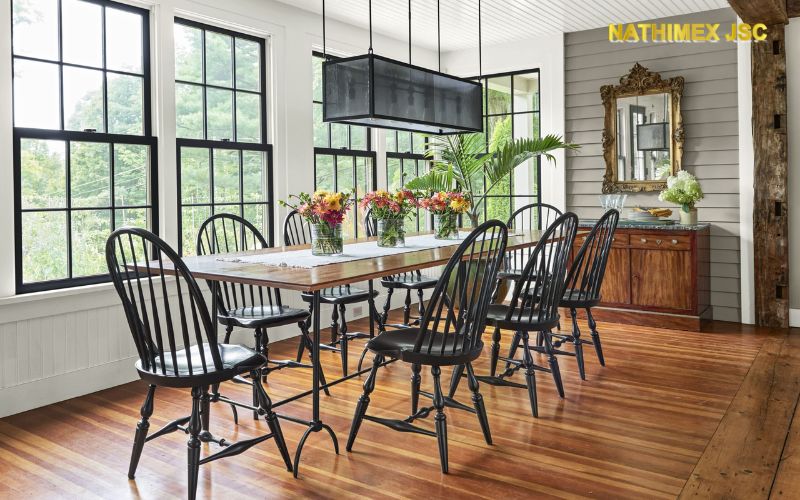Colors play a crucial role in interior design as they can affect our mood and perception of a space. They can evoke emotions, set the tone for a room, and even impact the way we feel. When it comes to choosing colors for your home, it's important to consider the overall theme, the function of the room, and how the colors work with each other.
-
1. The role of colors in interior design
Colors have a significant impact on the way we feel, behave, and perceive the world around us. They can evoke emotions, influence our mood, and even affect our physical health. In interior design, color plays an essential role in creating a harmonious and inviting space that reflects the personality and style of the homeowner.
Colors and Emotions: Colors have the power to evoke emotions and affect our mood. For example, red is associated with passion and energy, while blue is associated with calmness and tranquility. When choosing colors for your home, it's important to consider the emotions and moods you want to create in each room. A bedroom, for example, may benefit from calming colors such as blue, green, or lavender, while a living room may benefit from warmer tones such as yellow, orange, or red.
Colors and Perception of Space: Colors can also influence the way we perceive space. Lighter colors can make a room feel more spacious and open, while darker colors can make a room feel more intimate and cozy. When choosing colors for your home, it's important to consider the size and shape of each room. A small room may benefit from lighter colors such as white or cream to create the illusion of space, while a large room may benefit from darker colors such as navy or charcoal to create a more intimate atmosphere.

Colors and Style: Colors can also reflect the personality and style of the homeowner. Bold and vibrant colors can create a dramatic and modern look, while neutral colors can create a timeless and classic look. When choosing colors for your home, it's important to consider your personal style and preferences. A homeowner who loves bold colors may choose to paint a feature wall in a bright red or orange, while a homeowner who prefers a more understated look may choose to stick with neutral tones such as beige or gray.
Color Combinations: In interior design, color combinations are crucial to creating a cohesive and harmonious space. Certain color combinations work well together, while others can clash and create an unbalanced look. When choosing colors for your home, it's important to consider the color wheel and complementary colors. For example, blue and orange are complementary colors that work well together, while blue and red can create a clash.
The role of colors in interior design is crucial to creating a harmonious and inviting space. By considering the emotions and moods you want to create, the size and shape of each room, your personal style and preferences, and color combinations, you can create a space that reflects your personality and style while also promoting a sense of balance and harmony. Whether you choose bold and vibrant colors or neutral and understated tones, the colors you choose can make all the difference in creating a beautiful and inviting home.
-
2. Beautiful wood floor color palettes that are popular
Wood floors are a timeless and classic choice for any home. They offer warmth, durability, and natural beauty that can enhance the overall look and feel of any space. One of the key decisions when choosing wood floors is selecting the color palette that will best suit your home and personal style. Here are some beautiful wood floor color palettes that are popular today.
Warm Tones: Warm-toned wood floors are a classic choice that can create a cozy and inviting atmosphere in any space. Colors like honey, amber, and caramel can bring warmth and depth to a room. They work particularly well in living rooms, dining rooms, and bedrooms. Warm-toned wood floors can complement a wide range of interior design styles, from traditional to contemporary.
Gray Tones: Gray-toned wood floors are a popular choice for modern and minimalist spaces. They offer a clean and neutral look that can complement a wide range of interior design styles. Gray tones can range from light and airy to deep and moody, making them a versatile choice for any space. They work particularly well in open-concept spaces, where they can create a cohesive and flowing look.
Dark Tones: Dark-toned wood floors can create a dramatic and luxurious atmosphere in any space. Colors like espresso, mahogany, and ebony can add richness and depth to a room. They work particularly well in formal spaces like dining rooms and home offices. Dark-toned wood floors can complement a wide range of interior design styles, from traditional to contemporary.

Whitewashed Tones: Whitewashed wood floors are a popular choice for coastal and beach-inspired spaces. They offer a light and airy look that can create a relaxed and casual atmosphere in any room. Colors like driftwood and bleached oak can add texture and dimension to a space. Whitewashed wood floors work particularly well in bedrooms, bathrooms, and living rooms.
Multi-Tonal Tones: Multi-tonal wood floors are a popular choice for those who want to add visual interest and texture to a space. They offer a dynamic and layered look that can create a unique and personalized atmosphere in any room. Multi-tonal wood floors can range from light and subtle to bold and dramatic, making them a versatile choice for any space. They work particularly well in open-concept spaces, where they can add depth and dimension to a room.
Beautiful wood floor color palettes can enhance the overall look and feel of any space. From warm-toned classics to modern grays, dark and dramatic shades, light and airy whitewashes, and multi-tonal textures, there is a wood floor color palette that can complement any interior design style and personal taste. By considering the mood and atmosphere you want to create in each room, you can select the perfect wood floor color palette that will bring natural beauty, warmth, and durability to your home.
-
3. How to coordinate wood floor colors with other furnishings in the house
Choosing the right wood floor color for your home is only the first step. Coordinating the wood floor color with other furnishings in the house is equally important to create a cohesive and harmonious look. Here are some tips to help you coordinate wood floor colors with other furnishings in your home.
Consider the Undertones: When choosing wood floor colors, it's important to consider the undertones. Undertones are the subtle hues that are present in the wood grain. For example, some wood species may have red or yellow undertones, while others may have gray or blue undertones. To coordinate wood floor colors with other furnishings in the house, look for items that have similar undertones. For example, if your wood floors have warm red undertones, consider pairing them with furnishings that have warm red or orange accents.
Contrast with Complementary Colors: Another way to coordinate wood floor colors with other furnishings is to create contrast with complementary colors. Complementary colors are colors that are opposite each other on the color wheel. For example, if your wood floors have warm red undertones, consider pairing them with furnishings that have cool green or blue accents. The contrast between warm and cool colors can create a dynamic and visually interesting look.

Match with Similar Colors: Matching wood floor colors with other furnishings in the house can create a cohesive and harmonious look. Look for items that have similar colors to your wood floors. For example, if your wood floors have a light, natural color, consider pairing them with light-colored furnishings like beige, cream, or white. This can create a clean and timeless look that will never go out of style.
Consider the Style: The style of your furnishings can also play a role in coordinating with wood floor colors. For example, if you have modern or minimalist furnishings, consider pairing them with wood floors that have cool gray undertones. If you have traditional or classic furnishings, warm-toned wood floors can create a cozy and inviting atmosphere.
Use Accessories to Tie Everything Together: Accessories can be a great way to tie everything together and coordinate wood floor colors with other furnishings in the house. Look for accessories like area rugs, throw pillows, and artwork that incorporate the colors of your wood floors and other furnishings. This can create a cohesive and visually interesting look that ties the entire room together.
Coordinating wood floor colors with other furnishings in the house is an important aspect of interior design. By considering undertones, creating contrast, matching colors, considering the style, and using accessories to tie everything together, you can create a cohesive and harmonious look that brings your home to life
-
4. Choosing wood floor colors based on the function of each room
When it comes to choosing wood floor colors, many people focus on the aesthetics without considering the function of the room. However, the function of a room should play a key role in selecting the right wood floor color. Here are some tips to help you choose wood floor colors based on the function of each room.
Living Room: The living room is a space for relaxation and entertainment, so it's important to choose wood floor colors that create a warm and inviting atmosphere. Consider warm-toned wood floor colors like red oak, maple, or cherry. These colors can create a cozy and inviting atmosphere that's perfect for lounging and entertaining.
Dining Room: The dining room is a space for formal occasions and family gatherings, so it's important to choose wood floor colors that are elegant and sophisticated. Consider dark-toned wood floor colors like mahogany, walnut, or dark oak. These colors can create a luxurious and elegant atmosphere that's perfect for formal dinners and special occasions.

Kitchen: The kitchen is a space that's all about function, so it's important to choose wood floor colors that are practical and easy to maintain. Consider light-toned wood floor colors like white oak, ash, or bamboo. These colors can create a bright and airy atmosphere that's perfect for cooking and entertaining.
Bedroom: The bedroom is a space for rest and relaxation, so it's important to choose wood floor colors that create a calming and soothing atmosphere. Consider cool-toned wood floor colors like gray oak, ash, or birch. These colors can create a serene and peaceful atmosphere that's perfect for winding down after a long day.
Home Office: The home office is a space for productivity and focus, so it's important to choose wood floor colors that create a clean and organized atmosphere. Consider light-toned wood floor colors like white oak or maple. These colors can create a bright and airy atmosphere that's perfect for working and staying focused.

Choosing the right wood floor color based on the function of each room is an important aspect of interior design. By considering the purpose of the room, you can choose wood floor colors that create the perfect atmosphere for relaxation, entertaining, cooking, working, or any other activity that takes place in your home. Whether you prefer warm, cool, dark, or light-toned wood floor colors, there's a perfect color to suit every room in your home.
-
5. Selecting wood floor colors according to feng shui principles
Feng shui is the ancient Chinese practice of creating a harmonious living space by balancing energy flow. Wood is an important element in feng shui and can be used to enhance the energy flow in a space. When selecting wood floor colors, it's important to consider feng shui principles to create a positive and balanced environment in your home. Here are some tips to help you select wood floor colors according to feng shui principles.
Determine the Bagua Map: The bagua map is a tool used in feng shui to determine the energy flow of a space. It's important to determine the bagua map of your home before selecting wood floor colors. This will help you identify the areas of your home that correspond to the five elements of feng shui (wood, fire, earth, metal, and water) and the colors associated with each element.
Choose Colors According to Bagua Areas: Once you have identified the bagua areas of your home, you can choose wood floor colors based on the colors associated with each area. For example, the east and southeast areas of the bagua map correspond to the wood element and are associated with green and brown colors. Consider wood floor colors like oak or maple that have natural brown or green tones to enhance the wood element in these areas.
Balance the Five Elements: In feng shui, it's important to balance the five elements to create a harmonious living space. If your home has an excess of one element, it can create an imbalance in the energy flow. When selecting wood floor colors, consider the other elements in the bagua areas and choose colors that balance the energy flow. For example, if the west area of the bagua map corresponds to the metal element, consider pairing light-colored wood floors with metal accents like silver or gold to balance the energy flow.
Consider Personal Preferences: While it's important to consider feng shui principles when selecting wood floor colors, it's also important to consider personal preferences. Your home should be a reflection of your personality and style. If a certain wood floor color speaks to you, it's okay to incorporate it into your home even if it doesn't correspond to the feng shui principles. After all, the most important thing is that you feel comfortable and happy in your living space.
Selecting wood floor colors according to feng shui principles can help create a positive and balanced environment in your home. By considering the bagua map, choosing colors based on bagua areas, balancing the five elements, and considering personal preferences, you can create a harmonious living space that enhances your well-being and happiness.
